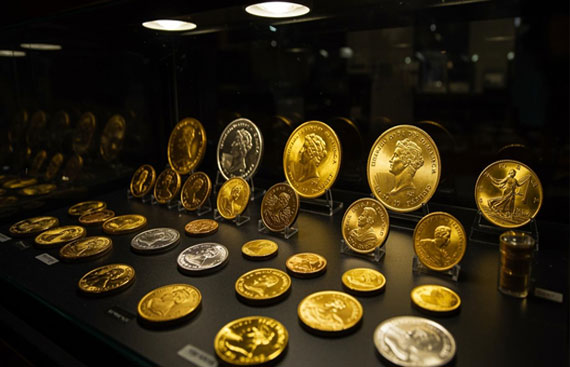State-Level Gold and Silver Policies Signal Monetary Shift, Gainesville Coins Reports

A wave of legislative changes across American states is quietly reshaping how precious metals are treated within the U.S. monetary system, potentially laying groundwork for broader federal policy shifts. The movement, largely overlooked by mainstream financial media, has gained traction in approximately 75% of states nationwide.
These policy changes represent the most significant reconsideration of precious metals' monetary role since the abandonment of the gold standard in 1971.
Legislative momentum builds across states
The scope of state-level precious metals legislation has expanded dramatically in recent years, encompassing tax policy, legal tender recognition, and regulatory framework adjustments.
"So it's a policy movement that's gaining momentum," observes Everett Millman, precious metals specialist at Gainesville Coins. "Yes, it's only taking place on the state level, so it doesn't obligate the federal government or the US Treasury to necessarily treat gold and silver differently."
Despite lacking direct federal authority, the breadth of state adoption suggests a fundamental shift in how policymakers view precious metals' economic role. States have pursued various approaches, from eliminating sales taxes on bullion transactions to recognizing gold and silver coins as legal tender for state obligations.
The legislative wave spans diverse political landscapes, indicating bipartisan support for precious metals policy reform. Conservative states have led the movement, but moderate jurisdictions have also embraced elements of these reforms.
Federal implications remain uncertain
While state policies cannot directly compel federal agencies to modify their precious metals treatment, the growing legislative consensus creates political pressure for national reconsideration.
"But I do think it is indicative of kind of a shift in thinking to recognize gold and silver more so as on par with things like the US dollar or US Treasury bonds than they have been in the past," Millman explains.
Federal monetary authorities have historically viewed precious metals as commodities rather than monetary instruments. However, widespread state recognition of their monetary character could influence future federal policy discussions, particularly given current monetary policy uncertainties.
The Trump administration's openness to unconventional economic approaches may create opportunities for federal-level precious metals policy consideration that would have been politically impossible in previous eras.
Economic theories gain practical application
State-level precious metals policies reflect broader concerns about monetary stability and fiscal discipline that have gained prominence among economists and policymakers.
Proponents argue that recognizing precious metals' monetary role provides important constraints on government spending and monetary expansion. These theoretical arguments now receive practical testing through state implementation.
Critics contend that returning to precious metals standards could limit economic flexibility during crises. However, current state policies stop short of mandating gold or silver backing for currencies, instead focusing on tax treatment and legal recognition.
Gainesville Coins Observes Market Response
The policy changes create tangible benefits for precious metals investors and dealers operating in reformed states. Elimination of sales taxes on bullion transactions reduces costs for smaller purchases, potentially expanding market participation.
Gainesville Coins has observed increased interest from investors in states implementing comprehensive precious metals reforms. The combination of tax advantages and legal recognition provides additional confidence for portfolio allocation decisions.
Legal tender recognition offers particular benefits by simplifying transaction reporting and reducing regulatory complications for precious metals businesses operating across state lines.
Investment landscape transformation
For precious metals investors, state policy reforms create meaningful improvements in investment economics. Reduced tax burdens enhance net returns, while legal recognition provides additional security for large transactions.
The reforms also eliminate administrative complexities that previously discouraged investment. When precious metals receive legal tender status, transactions become more straightforward from both legal and tax perspectives.
However, implementation varies significantly between states, requiring investors to understand specific local regulations before making purchase decisions.
Historical precedent suggests federal consideration
Previous instances of widespread state policy adoption have often preceded federal action on similar issues. The current precious metals movement follows this pattern, with state-level experimentation potentially informing future federal policy development.
The monetary policy environment also appears more conducive to precious metals consideration than in previous decades. Concerns about inflation, currency stability, and fiscal sustainability have renewed interest in monetary alternatives.
Federal precious metals policy changes would require congressional action, but growing state-level support could provide political momentum for such initiatives.
Gainesville Coins Anticipates Continued Expansion
The precious metals policy movement shows little sign of slowing, with additional states considering similar legislation. This momentum reflects broader concerns about monetary policy that extend beyond traditional precious metals advocacy.
As more states implement these reforms, the cumulative effect may eventually influence federal monetary policy discussions. The current administration's willingness to explore unconventional approaches increases the likelihood of serious federal consideration.
For investors, the evolving policy landscape provides increasing support for precious metals ownership while reducing traditional barriers to market participation. The transformation represents more than tax policy adjustment—it signals a fundamental reconsideration of precious metals' role in American finance.
